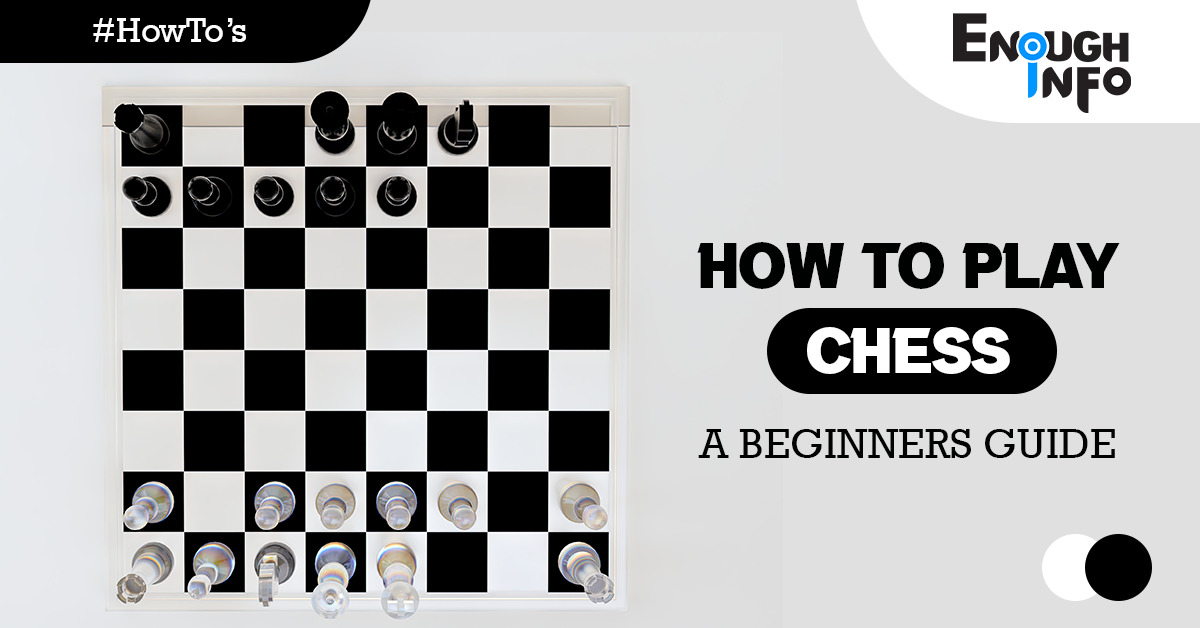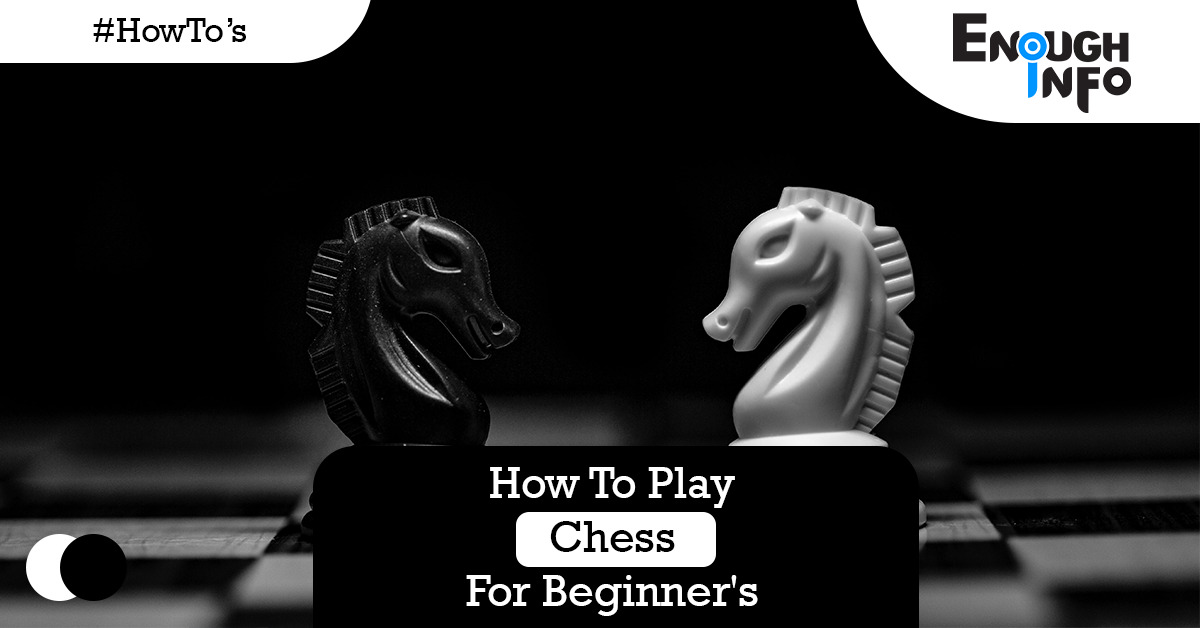
How To Play Chess For Beginners: Chess is a centuries-old and intellectually engaging game that has captivated people of many cultures. It is a strategy, patience, and critical thinking game that is popular among aficionados of all ages. If you’re new to chess and want to get started, this book will provide you with the fundamental knowledge and skills you’ll need. EnoughInfo.com

Read Also: How To Ice Skate( The You Need To Know)
Chess is one of the world’s oldest board games. It has been played and enjoyed for centuries, but in recent years it has seen a spike in popularity, with thousands of new players eager to learn the rules. How to tie a tie (A Step-by-Step Guide)
The popularity of Netflix show The Queen’s Gambit, and Twitch stars entering the PogChamps tournament and chess boxing have all contributed to an increase in chess interest since 2020. Chess.com experienced record traffic after a photo of Lionel Messi and Cristiano Ronaldo playing chess went viral.
Chess is undergoing a revival, but if you’re new to the game, mastering the rules and varied strategies can be daunting. This is when our expert comes in. We’ll go through the basic rules and fundamental guide.
Read Also: How To Earn In Ragnarok Labyrinth NFT
FAQs & Answers
1. How long does it take to learn how to play chess?
Learning chess takes different amounts of time for different people. Within a few weeks of persistent practise and study, a beginner can get familiar with the basic rules and tactics. Mastering chess and attaining a high level of play, on the other hand, can require years of concentrated learning and experience.
2. What should I do if I become trapped in the middle of a game?
If you find yourself in a difficult situation or are unsure of your next move, take a moment to evaluate the board. Look for tactical chances, potential dangers, and the effects of various moves. Consult chess websites, books, or seek advice from experienced players if necessary to broaden your understanding and find a suitable solution. How To Make Homemade Pizza Dough
3. Is it necessary to memorise chess openings?
For novices, memorising chess openings is not required. However, it is beneficial to become acquainted with a few basic openings in order to understand popular strategic ideas and improve your game. As you advance and meet more difficult opponents, studying and memorising more openings can give you an advantage.
4. What should I do to improve my chess skills?
Learning to play chess requires a combination of study, practise, and analysis. Read chess strategy, tactics, and endgame literature. Solve puzzles, analyse your games to uncover flaws, and play against opponents of varied skill levels on a regular basis. Studying grandmaster games and asking advice from experienced players or coaches can also help you comprehend and grow.
5. Do various time controls exist in chess?
There are different time controls in chess. Traditional games often feature lengthier time limitations, giving players more time for in-depth analysis and strategic planning. Rapid and blitz chess have lower time constraints, encouraging quicker and more spontaneous decision-making. Each time control provides a distinct playing experience and caters to various preferences.
Read Also: 10 Ways To Reduce Lag When Gaming Online
How to Play Chess and Master the Game – A Beginner’s Guide

1. Familiarize Yourself with the Chessboard:
The chessboard is made up of 64 squares that are alternately coloured in light and dark colours. Each player begins with a king, a queen, two rooks, two knights, two bishops, and eight pawns. Understand how the pieces move and their relative values. The goal of the game is to checkmate your opponent’s king, trapping it in a position from which it cannot escape.
2. Master Each Piece’s Movement:
The Chess Pieces’ Movement
Each of the six various types of pieces moves in a unique way. Pieces cannot move through other pieces (though the knight can jump over them) and can never move onto a square occupied by one of their own pieces. They can, however, be moved to replace an opponent’s piece, which is subsequently captured. Pieces are often manoeuvred into places where they can capture other pieces (by landing on their square and then replacing them), defend their own pieces in the event of capture, or control key squares in the game.
In Chess, How to Move the King
The King is the most important yet weakest component. The king can move one tile up, down, sideways, or diagonally. The king cannot be caught in check.The term “check” refers to when the king is attacked by another piece.
Read Also: How to play guitar chords(All You Need To Know)
In Chess, How Do You Move The Queen?
The most powerful piece is the queen. She can move as far as she can in any one straight direction – forward, backward, sideways, or diagonally – as long as she does not pass through any of her own pieces. How To Cook Scrambled Eggs (Step By Step)
And, as with all pieces, capturing an opponent’s piece ends the queen’s turn. Take note of how the white queen captures the black queen, forcing the black king to flee.
In Chess, How To Move The Rook
The rook has the ability to travel as far as it wishes, but only forward, backward, and to the sides. When the rooks are protecting and working together, they are especially powerful!
In Chess, How Do You Move The Bishop?
The bishop has the ability to move as far as it wishes, but only diagonally. Each bishop begins on one colour (light or dark) and must remain on that colour at all times. Bishops get along well because they conceal each other’s flaws.
In Chess, How Do You Move The Knight?
Knights move differently than the other pieces, travelling two squares in one direction and then one more move at a 90-degree angle, resembling the shape of a “L.” In addition, knights are the only pieces that can move over other pieces.
In Chess, How Do You Move Your Pawn?
Pawns are special in that they advance when moving forward and capture while moving diagonally. Except on their first move, when they can move two squares forward, pawns can only advance one square at a time. Pawns can only advance diagonally and take one tile at a time. They can never move or capture in reverse. If another piece is immediately in front of a pawn, he cannot advance past or capture it.
3. Learn the Game’s Objective:
Checkmate your opponent’s king to win at chess. This entails putting their monarch in a position where it is under attack and cannot flee. It is important to remember, however, that the game might also conclude in a draw due to a variety of causes such as stalemate or inadequate material to checkmate. How To Sew A Button (Step-By-Step Guide)
4. Understand the Fundamental Strategies:
a. Control the Centre: Position your pieces in the centre of the board to gain control of the entire chessboard.
b. Create Your Pieces: Increase your mobility and cohesion by moving your pawns and minor pieces (knights and bishops) to active squares.
c. Protect Your King: Build your castle early to protect your king and connect your rooks.
d. Plan ahead of time: Anticipate your opponent’s movements and devise counterstrategies while keeping your goals in mind.
Read Also: How To Improve Your Cognitive Skills
5. Practise Tactical Moves:
Chess is a tactical game. Learn about fundamental ideas including forks, pins, skewers, and discovered assaults. To increase your ability to detect these possibilities during a game, solve puzzles and practise tactical exercises.
6. Study Classic Openings:
To get your games started, learn a few basic openings. Openings like the Italian Game, the Spanish Game (Ruy Lopez), and the Sicilian Defence can help you build solid foundations and understand basic strategic notions.
7. Analyse Your Games:
After playing a game, go through your plays and decisions. Recognise your own skills and shortcomings, learn from your failures, and seek to improve your performance with each match.
8. Play Frequently and Seek Guidance:
Consistent practise is the best way to progress. Play online and offline against opponents of varying skill levels. Join a chess club in your area or seek advice from experienced players or instructors who can provide useful insights and help you grow.
Read Also: How to Have a Healthy Brain( Requirements)
Conclusion on how to play chess
Chess is a game that rewards hard work, critical thinking, and a desire to grow. By becoming acquainted with the rules, learning fundamental techniques, and practising on a regular basis, you will progressively improve your skills and get a greater appreciation for the game’s intricacy and beauty. So take a chessboard, locate a worthy opponent, and begin on a fascinating intellectual journey.
Recommended;
Tips For Thinking Positively At Work
How To Stop Overthinking(The Ultimate Guide)
How To Be A Better Sports Player




